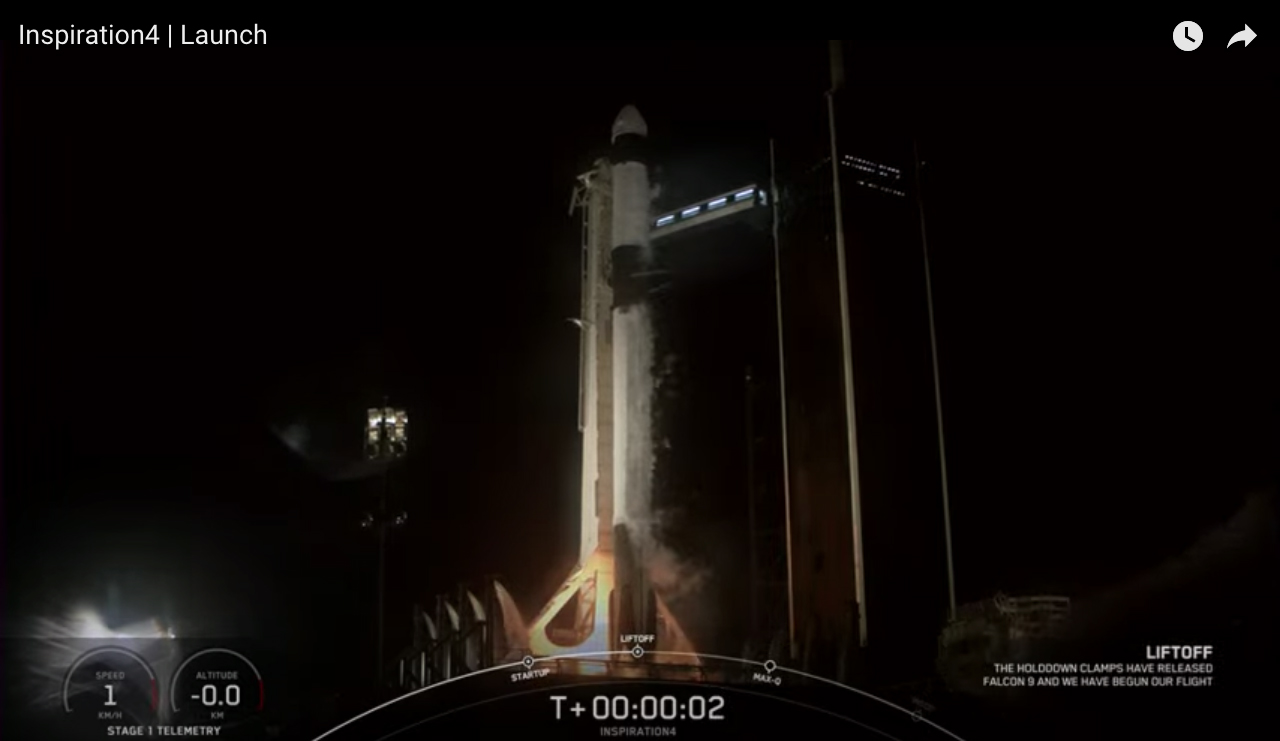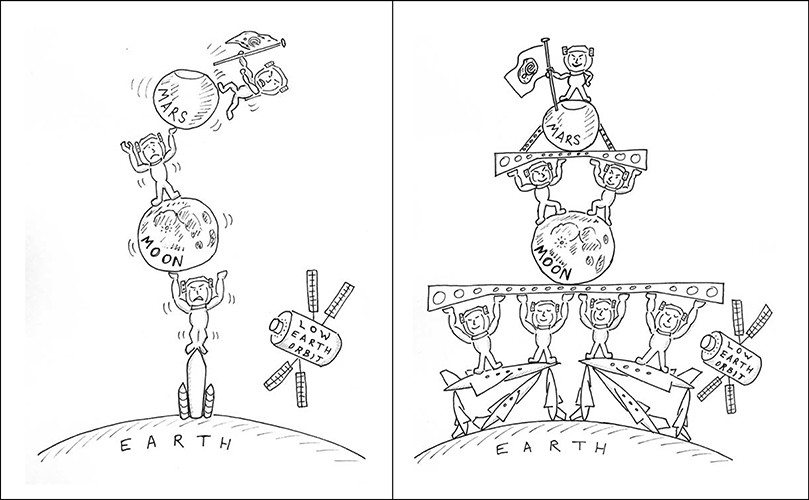= ASTRONAUTICAL EVOLUTION =
Issue 160, 16 September 2021 – 52nd Apollo Anniversary Year
| Site home | Chronological index | Subject index | About AE |
This post is also available on Wordpress
The Inspiration4 Mission Begins to Fill In the Bottom of the Transport Pyramid
The Inspiration4 mission restarts private passenger spaceflight
Now that the Inspiration4 mission is safely in orbit, it will be good to think about what this critically important flight means for the longer-term outlook in manned spaceflight. (Note for pedants: the adjective “manned” is, and always has been, non-gender specific.)
This is the first flight with an all-civilian crew, meaning that none of the four space travellers are professional astronauts – just as passengers on jet airliners today are not professional aeronauts.
We’ve been inching towards this for a long time. The first non-astronaut/cosmonaut space travellers, while still being state-sponsored, must have been Konstantin Feoktistov and Boris Yegorov as far back as 1964 on Voskhod 1. They were followed by about sixty payload specialists on US Shuttle missions. Meanwhile the Soviet Union was flying a number of guest cosmonauts from Soviet bloc countries to Salyuts 6 and 7 and to Mir in their Interkosmos programme – including a Japanese TV journalist, and Britain’s Helen Sharman. All these space travellers were paid for by either their governments or commercial corporations.
The first fully privately funded manned space mission appears to have been Soyuz TM-30 in April to June 2000, which was chartered by MirCorp and flown by Soviet cosmonauts Sergei Zalyotin and Aleksandr Kaleri. Their mission was to refurbish the Soviet Mir space station for subsequent commercial use. Further missions were planned, but were not flown due to lack of investment funding, and Mir was de-orbited the following year.
The first space travellers who paid their own way into space were the seven high-net-worth individuals, starting with Dennis Tito, who made eight visits to the International Space Station (one of them flew twice) during the period 2001-2009. Transport was provided by the Russian Soyuz, and their flights organised by Space Adventures. One of the outstanding results of the ISS programme has been the discovery that wealthy individuals are willing to pay multiple tens of millions of dollars, learn Russian and submit to the rigours of a six-month training programme in order to spend a week in orbit, even on a station far from ideal as a visitor attraction.
Now, at last and after a 12-year hiatus, the pieces are finally coming into position to support a genuine private passenger transport industry capable of sustainable growth. In addition to the purely SpaceX-operated Inspiration4 mission, the first flight organised by Axiom Space is due next January, using a SpaceX Dragon to visit the ISS as part of Axiom Space’s buildup towards building and operating its own space stations. Meanwhile the Russians are planning more private visits to the ISS on Soyuz MS-19 and MS-20 towards the end of this year, one of which will fly Japanese client Yusaku Maezawa in partnership with Space Adventures.
For a list of more upcoming flights and commentary, see Robert Zimmerman’s Behind the Black blog.
Now we need to ask: Why is this activity so important for the development of a spacefaring civilisation?
An Earth-Moon-Mars passenger transport pyramid
In any technologically mature, economically sustainable transport system, shorter, cheaper journeys are made more frequently than longer, more expensive ones.
Apparently manned spaceflight engineers and their paymasters in government or in boardrooms have not yet discovered this commonplace fact.
People generally travel around their home town every day. They might typically make a journey to another town in the same country once a week or so, and perhaps visit a foreign country or make an intercontinental flight once every few months to a year. A voyage around the world, an expedition to the South Pole or to the summit of Mount Everest, a spaceflight to the ISS or a deep dive to the wreck of the RMS Titanic – for most people these would be once-in-a lifetime events.
In other words, measured in number of traffic movements, there is a pyramid of activity. The local, easily affordable trips create a wide base which supports, both technologically and economically, progressively narrower higher levels of progressively more ambitious, more costly and longer-range journeys.
How might this apply to space travel?
This was the subject of a paper of mine that was published in the Journal of the British Interplanetary Society in May 2018.
Suppose we aim for a situation in which, say, 10 people fly to/from Mars per year (so 20 per two-year window, but the exact numbers don’t matter). Then a well-designed transport system will look something like this:
- 10 passengers to/from Mars per year;
- 100 passengers to/from the surface of the Moon per year;
- 1000 passengers to/from high Earth orbit (with lunar flyby) per year;
- 10,000 passengers to/from LEO space hotels per year.
The factor of ten at each stage is purely speculative. It might be more, or a bit less. The important point is the principle: that the number of shorter-range, cheaper journeys made every year should be a multiple of the longer-range, more expensive ones.
Of course this is the exact opposite of the usual space agency paradigm in which LEO activity must be cancelled in order to fund a Moon programme, the Moon must be cancelled in order to free up funds for Mars, and so on. The illusion of progress must be maintained by aiming for more ambitious targets, but none of those targets can be made permanent.
While nobody I know of seems to be consciously aiming to develop a pyramidal pattern of activity, the gradual regularisation of non-astronaut space travellers from Voskhod 1 in 1964 to Inspiration4 today, coupled with the continued delay in surmounting the obstacles to returning to the Moon, let alone going further to Mars, is having the same effect.
I predict that the pyramid will emerge naturally as spaceflight continues to develop.
| Site home | Chronological index | About AE |

